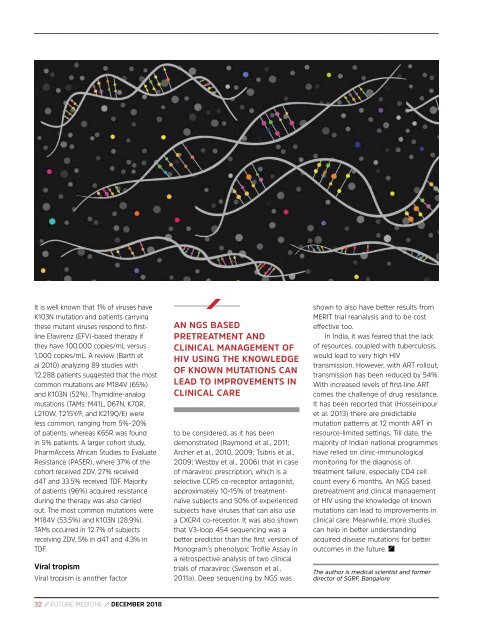FM DECEMBER 2018 ISSUE - digital edition
Create successful ePaper yourself
Turn your PDF publications into a flip-book with our unique Google optimized e-Paper software.
It is well known that 1% of viruses have<br />
K103N mutation and patients carrying<br />
these mutant viruses respond to firstline<br />
Efavirenz (EFV)-based therapy if<br />
they have 100,000 copies/mL versus<br />
1,000 copies/mL. A review (Barth et<br />
al 2010) analyzing 89 studies with<br />
12,288 patients suggested that the most<br />
common mutations are M184V (65%)<br />
and K103N (52%). Thymidine-analog<br />
mutations (TAMs: M41L, D67N, K70R,<br />
L210W, T215Y/F, and K219Q/E) were<br />
less common, ranging from 5%–20%<br />
of patients, whereas K65R was found<br />
in 5% patients. A larger cohort study,<br />
PharmAccess African Studies to Evaluate<br />
Resistance (PASER), where 37% of the<br />
cohort received ZDV, 27% received<br />
d4T and 33.5% received TDF. Majority<br />
of patients (96%) acquired resistance<br />
during the therapy was also carried<br />
out. The most common mutations were<br />
M184V (53.5%) and K103N (28.9%).<br />
TAMs occurred in 12.7% of subjects<br />
receiving ZDV, 5% in d4T and 4.3% in<br />
TDF.<br />
Viral tropism<br />
Viral tropism is another factor<br />
AN NGS BASED<br />
PRETREATMENT AND<br />
CLINICAL MANAGEMENT OF<br />
HIV USING THE KNOWLEDGE<br />
OF KNOWN MUTATIONS CAN<br />
LEAD TO IMPROVEMENTS IN<br />
CLINICAL CARE<br />
to be considered, as it has been<br />
demonstrated (Raymond et al., 2011;<br />
Archer et al., 2010, 2009; Tsibris et al.,<br />
2009; Westby et al., 2006) that in case<br />
of maraviroc prescription, which is a<br />
selective CCR5 co-receptor antagonist,<br />
approximately 10-15% of treatmentnaïve<br />
subjects and 50% of experienced<br />
subjects have viruses that can also use<br />
a CXCR4 co-receptor. It was also shown<br />
that V3-loop 454 sequencing was a<br />
better predictor than the first version of<br />
Monogram’s phenotypic Trofile Assay in<br />
a retrospective analysis of two clinical<br />
trials of maraviroc (Swenson et al.,<br />
2011a). Deep sequencing by NGS was<br />
shown to also have better results from<br />
MERIT trial reanalysis and to be cost<br />
effective too.<br />
In India, it was feared that the lack<br />
of resources, coupled with tuberculosis,<br />
would lead to very high HIV<br />
transmission. However, with ART rollout,<br />
transmission has been reduced by 54%.<br />
With increased levels of first-line ART<br />
comes the challenge of drug resistance.<br />
It has been reported that (Hosseinipour<br />
et al. 2013) there are predictable<br />
mutation patterns at 12 month ART in<br />
resource-limited settings. Till date, the<br />
majority of Indian national programmes<br />
have relied on clinic-immunological<br />
monitoring for the diagnosis of<br />
treatment failure, especially CD4 cell<br />
count every 6 months. An NGS based<br />
pretreatment and clinical management<br />
of HIV using the knowledge of known<br />
mutations can lead to improvements in<br />
clinical care. Meanwhile, more studies<br />
can help in better understanding<br />
acquired disease mutations for better<br />
outcomes in the future.<br />
The author is medical scientist and former<br />
director of SGRF, Bangalore<br />
32 / FUTURE MEDICINE / <strong>DECEMBER</strong> <strong>2018</strong>


















